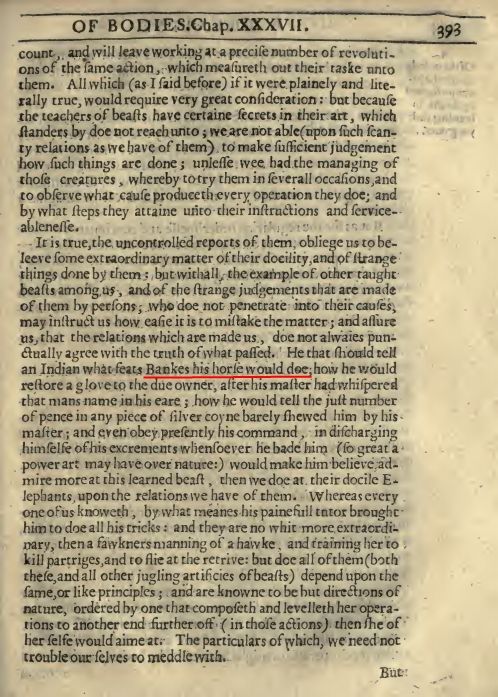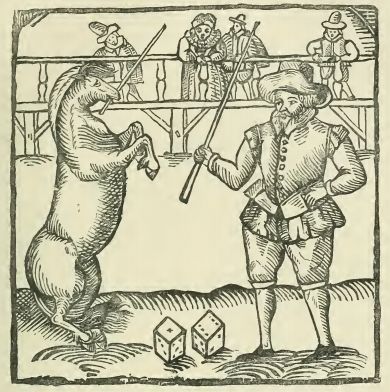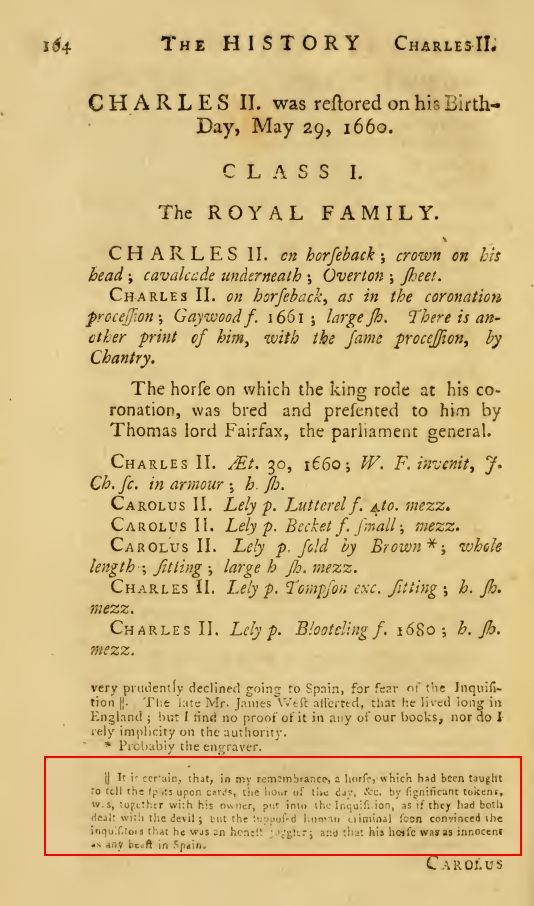Let’s return again to Shakespeare, but for a
different reason. In Act 1, Scene 2 of Love’s Labour’s Lost, the
character Moth, speaking about some simple arithmetic, says,
“The dancing horse will tell you.”
This is a reference to a well-known horse in Shakespeare’s
day. He was a bay gelding called Morocco (or Marocco) belonging to a Scotsman
called Banks, who had trained him to perform a number of tricks. Sir Kenelm Digby, in his Treatise on the Nature of Bodies (1645) describes Morocco,
“… what feats Bankes his horfe would doe; how he would restore a glove to the due owner, after his master had whifpered that mans name in his eare; how he would tell the juft number of pence in any piece of filver coyne barely fhewed him by his mafter.”
 |
| Kenelm Digby - Treatise on the Nature of Bodies - 1645 |
Banks showed his marvellous horse in the tavern
yard of the Belle Savage Inn, with the audience watching from the
galleries surrounding the yard. Morocco would tap out the number of coins shown
to him or the numbers on the faces of dice, he would prance on his hind-legs
and, shod in silver, would dance the ‘Canaries’, a popular dance of the
time. In 1596, Banks took his horse back to Scotland and Patrick Anderson, the
author, records,
“This man [Banks] would borrow from 20 to 30 of the spectators a piece of gold or silver, put all in a bag, and shuffle them together; thereafter he would bid the horse give every gentleman his own piece of money again.”
Another story concerns Tarleton, the favourite jester at
Elizabeth I’s court, who went to see Morocco perform at the Cross Keys tavern.
Banks spotted Tarleton and asked Morocco to, “…go fetch me the veriest fool
in the company,” whereupon the horse went into crowd and, with his mouth,
chose Tarleton and led him out to the front. As he went forward, Tarleton
called out, “God a mercy, Horse,” which instantly became a popular
catchphrase, heard all across London. At first, Tartleton was amused but soon
became annoyed with the mockery from the crowd and said to Banks that he would
have the horse bring him the greatest whoremaster in the company. Banks
addressed Morocco and gave him that instruction, and the horse went straight to
his master and brought him forward, causing the crowd to erupt with more
laughter, none more than Tarleton himself.
 |
| Banks and Morocco |
Morocco became very famous, a ballad
(now lost) was written about him, as was a tract Maroccus Extaticus or,
Bankes Bay Horse in a Trance (1595) a dialogue that has little to do with
the horse itself. The fame of Morocco spread further when, in 1600, he was
taken up the spire of Old St Paul’s cathedral. A jest-book says that a serving
man rushed into the church, urging his master who was inside to come outside
and see the horse on the roof. “Away, you fool!” came the answer,
“What need I go so far to see a horse on the top, when I can see so many asses at the bottom!”
The following year, Banks took his horse across the Channel but
very nearly came to grief when the Capuchin monks of Orleans accused Banks and
Morocco of magical practices and of being in league with the Devil. The astute
Scotsman got the horse to select a gentleman from the crowd who had a cross on
his hat, to bow and kneel before the holy symbol and to kiss it. Nothing
diabolic could possibly manage to be so close to something so sacred, he
argued.
 |
| Morocco and Banks |
When Banks returned to London, he became a vintner – he was mentioned
in Moll Cutpurse’s autobiography,
“I shall never forget my fellow humourist Banks, the vintner in Cheapside, who taught his horse to dance and shooed him with silver.”
There was story that Banks and Morocco had been burnt as heretics
in Rome on the orders of the Pope, something to which Ben Jonson alludes in his
A Voyage Abroad,
“But 'mongst these Tiberts, who do you think there was?Old Banks the juggler, our Pythagoras,Grave tutor to the learned horse; both which,Being, beyond sea, burned for one witch,Their spirits transmigrated to a cat.”
 |
| Ben Jonson - A Voyage Abroad |
Edward Kelley, assistant to Dr John Dee, the
Elizabethan astrologer, had his performing horse burnt as a heretic in Prague
on the orders of Emperor Rudolph. In 1707, another English horse that had been
taught by its owner to play cards was also burnt at Lisbon. Yet another case,
later in the eighteenth century, was recorded by James Granger in his Biographical
History of England (1775),
“In my remembrance a horse which had been taught to tell the spots upon cards, the hour of the day, &c., by significant tokens, was together with his owner put into the Inquisition as if they had both dealt with the devil, but the supposed human criminal soon convinced the Inquisition that he was an honest Juggler, and that his horse was as innocent as any beast in Spain.”
 |
| James Granger - Biographical History of England - 1775 |
No comments:
Post a Comment